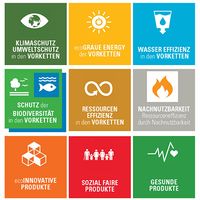Sustainable products
When are products sustainable?
Sustainability is a widely used term with somewhat fluid meanings. Wood products are generally considered sustainable because:
• wood absorbs and binds CO2, and
• wood is a product of sustainable forest management. In view of the complexity of sustainability, the above definition may be over-simplified. Let us take a closer look at the term.
(1) The original definition of sustainability by the World Commission on Environment and Development (WCED):
In 1983 the United Nations established the World Commission on Environment and Development (WCED). In 1987 the commission published a report entitled ‘Our Common Future’ (commonly known as the Brundtland Report), which marked the environment and development policies and set the guiding principles for sustainable development, which are primarily focused on sustainable management of nature and resources. Sustainable development was defined as “development that meets the needs of the present generation without compromising the ability of future generations to meet their own needs”. The above definition provided the UN’s Brundtland Report is still valid as the first formalization of sustainability. The idea of careful management of nature and resources was very early adopted by the German forest management.
(2) The Three-Pillar Model
The European Commission of Inquiry has promoted the now-common sustainable development model that is based on three pillars: economic, environmental and social. The Commission set out the guiding principles of future-oriented sustainable development as consisting of three dimensions: the ecological, economic and social dimension. The ecological dimension is based on the following sustainability rules: (a) The rate of exploitation of natural resources should not exceed their regeneration or functional replacement rate. (b) Emissions should be kept at or below the waste-absorptive capacity of the environment. (c) Threats or unacceptable risks to people and the environment should be prevented. (d) The duration of human interventions in the environment must be balanced against the time nature needs to self-stabilise. On the one hand, sustainable development is concerned with the economic and social component, separated from the strong original ecological connotation. On the other hand, the studies of the ecological dimension show that in order to be truly sustainable, wood products need to reach beyond the benefits of CO2 storage and sustainable forest management.
(3) UN Sustainable Development Goals
UN Sustainable Development Goals Today, global sustainability action is normally associated with the United Nations Sustainable Development Goals (SDS), which summarise 17 main challenges presented in the above picture.
Several of these 17 goals address the area of products. Sustainable products have to meet these goals; for wood products, the following are particularly relevant
• Affordable and clean energy
• Climate action
• Conservation of biodiversity (on land and in water)
• Clean water and sanitation
• Responsible consumption and production
• Socially fair products
• Good health and well-being
The Low Carbon Timber toolkit and instruments are aimed at achieving these goals directly or indirectly.


